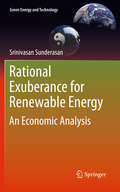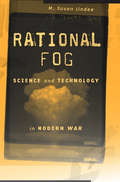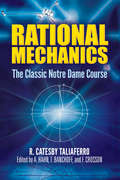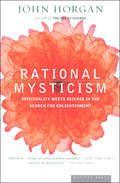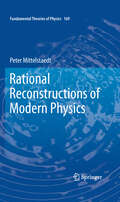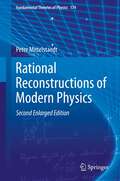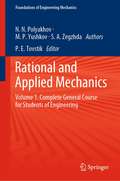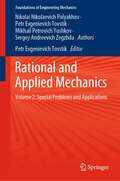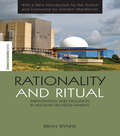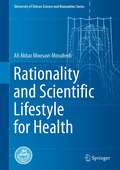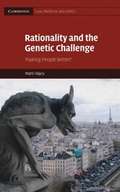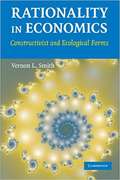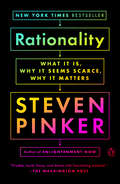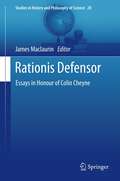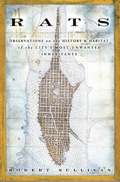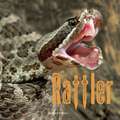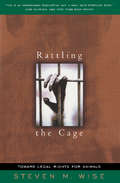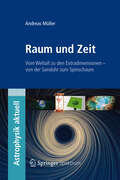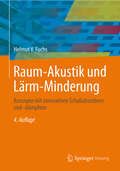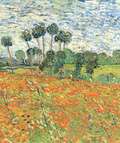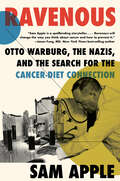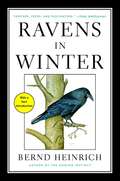- Table View
- List View
Rational Exuberance for Renewable Energy
by Srinivasan SunderasanRational Exuberance for Renewable Energy is a beyond-the-hype account of the underlying issues that encourage or plague widespread dissemination of renewable energy (RE) technologies. Renewable energy operates in the real world, and it cannot be assumed that the conventional theories and incentive structures of economics and business do not apply. The author argues that grants and subsidies could be provided to support research, development and technology improvement efforts, but should not be employed as an instrument of state policy to intervene in specific markets. It is important to recognize that although investors often demonstrate an appetite for market risk, they find technology risks and policy uncertainty much less appealing. Rational Exuberance for Renewable Energy blends classical economic theory with the everyday realities of the RE industry to identify incentive structures contributing to the success - or otherwise - of project implementation involving renewable sources and appropriate technologies. The book is a compilation of articles that analyze individual RE technologies, and offer multiple perspectives of the RE industry and markets. Rational Exuberance for Renewable Energy is intended for policy makers, advanced students of energy economics and sustainable development, and for potential mainstream investors.
Rational Fog: Science And Technology In Modern War
by M. Susan LindeeA thought-provoking examination of the intersections of knowledge and violence, and the quandaries and costs of modern, technoscientific warfare.Science and violence converge in modern warfare. While the finest minds of the twentieth century have improved human life, they have also produced human injury. They engineered radar, developed electronic computers, and helped mass produce penicillin all in the context of military mobilization. Scientists also developed chemical weapons, atomic bombs, and psychological warfare strategies.Rational Fog explores the quandary of scientific and technological productivity in an era of perpetual war. Science is, at its foundation, an international endeavor oriented toward advancing human welfare. At the same time, it has been nationalistic and militaristic in times of crisis and conflict. As our weapons have become more powerful, scientists have struggled to reconcile these tensions, engaging in heated debates over the problems inherent in exploiting science for military purposes. M. Susan Lindee examines this interplay between science and state violence and takes stock of researchers’ efforts to respond. Many scientists who wanted to distance their work from killing have found it difficult and have succumbed to the exigencies of war. Indeed, Lindee notes that scientists who otherwise oppose violence have sometimes been swept up in the spirit of militarism when war breaks out.From the first uses of the gun to the mass production of DDT and the twenty-first-century battlefield of the mind, the science of war has achieved remarkable things at great human cost. Rational Fog reminds us that, for scientists and for us all, moral costs sometimes mount alongside technological and scientific advances.
Rational Mechanics: The Classic Notre Dame Course
by R. Catesby Taliaferro F. Crosson A. Hahn T. BanchoffDeveloped from a classic undergraduate course on the study of the motion of bodies, this volume stresses the history of science as well as relevant physics and mathematics. R. Catesby Taliaferro developed a well-attended and much-revered course during his 20-year tenure at Notre Dame. He left among his papers the unfinished manuscript for this text, which has now been completed and prepared for publication by a group of his former students and colleagues.Suitable for undergraduates and beginning graduate students of physics and the history of science, this volume begins with an exploration of ancient Greek celestial mechanics and the seventeenth-century scientific revolution incited by Kepler's work. Subsequent chapters examine vector spaces and their applications, elementary differential geometry, particle dynamics, displacement and kinematics, theories of light, and the special theory of relativity.
Rational Mysticism: Spirituality Meets Science in the Search for Enlightenment
by John HorganIn Rational Mysticism, acclaimed journalist John Horgan embarks on an adventure of discovery, investigating the ways in which scientists, theologians, and philosophers are attempting to formulate an empirical explanation of spiritual enlightenment. Horgan visits and interviews a fascinating Who's Who of experts, including theologian Huston Smith; Andrew Newberg, explorer of the brain's "God module"; Ken Wilber, a transpersonal psychologist and Buddhist; psychedelic pharmacologist Alexander Shulgin; Oxford-educated psychologist and Zen practitioner Susan Blackmore; and postmodern shaman Terence McKenna. Horgan also explores the effects of reputed enlightenment-inducing techniques such as fasting, meditation, prayer, sensory deprivation, and drug trips. In his lively and thought-provoking inquiry, Horgan finds surprising connections among seemingly disparate disciplines, not the least of which is a shared awe of the nature of the universe.
Rational Reconstructions of Modern Physics
by Peter MittelstaedtNewton’s classical physics and its underlying ontology are loaded with several metaphysical hypotheses that cannot be justified by rational reasoning nor by experimental evidence. Furthermore, it is well known that some of these hypotheses are not contained in the great theories of modern physics, such as the theory of relativity and quantum mechanics. This book shows that, on the basis of Newton’s classical physics and by rational reconstruction, the theory of relativity as well as quantum mechanics can be obtained by partly eliminating or attenuating the metaphysical hypotheses. Moreover, it is shown that these reconstructions do not require additional hypotheses or new experimental results.
Rational Reconstructions of Modern Physics, 2nd Enlarged Edition
by Peter MittelstaedtNewton's classical physics and its underlying ontology are loaded with several metaphysical hypotheses that cannot be justified by rational reasoning nor by experimental evidence. Furthermore, it is well known that some of these hypotheses are not contained in the great theories of Modern Physics, such as the theory of Special Relativity and Quantum Mechanics. This book shows that, on the basis of Newton's classical physics and by rational reconstruction, the theory of Special Relativity as well as Quantum Mechanics can be obtained by partly eliminating or attenuating the metaphysical hypotheses. Moreover, it is shown that these reconstructions do not require additional hypotheses or new experimental results. <P><P> In the second edition the rational reconstructions are completed with respect to General Relativity and Cosmology. In addition, the statistics of quantum objects is elaborated in more detail with respect to the rational reconstruction of quantum mechanics. The new material completes the approach of the book as much as it is possible at the present state of knowledge. Presumably, the most important contribution that is added to the second edition refers to the problem of interpretation of the three great theories of Modern Physics. It is shown in detail that in the light of rational reconstructions even realistic interpretations of the three theories of Modern Physics are possible and can easily be achieved.
Rational and Applied Mechanics: Volume 1. Complete General Course for Students of Engineering (Foundations of Engineering Mechanics)
by Nikolai Nikolaevich Polyakhov Mikhail Petrovich Yushkov Sergey Andreevich ZegzhdaAvailable for the first time in English, this two-volume course on theoretical and applied mechanics has been honed over decades by leading scientists and teachers, and is a primary teaching resource for engineering and maths students at St. Petersburg University.The course addresses classical branches of theoretical mechanics (Vol. 1), along with a wide range of advanced topics, special problems and applications (Vol. 2). This first volume of the textbook contains the parts “Kinematics” and “Dynamics”. The part “Kinematics” presents in detail the theory of curvilinear coordinates which is actively used in the part “Dynamics”, in particular, in the theory of constrained motion and variational principles in mechanics. For describing the motion of a system of particles, the notion of a Hertz representative point is used, and the notion of a tangent space is applied to investigate the motion of arbitrary mechanical systems. In the final chapters Hamilton-Jacobi theory is applied for the integration of equations of motion, and the elements of special relativity theory are presented.This textbook is aimed at students in mathematics and mechanics and at post-graduates and researchers in analytical mechanics.
Rational and Applied Mechanics: Volume 2. Special Problems and Applications (Foundations of Engineering Mechanics)
by Nikolai Nikolaevich Polyakhov Mikhail Petrovich Yushkov Sergey Andreevich Zegzhda Petr Evgenievich TovstikAvailable for the first time in English, this two-volume course on theoretical and applied mechanics has been honed over decades by leading scientists and teachers, and is a primary teaching resource for engineering and maths students at St. Petersburg University.The course addresses classical branches of theoretical mechanics (Vol. 1), along with a wide range of advanced topics, special problems and applications (Vol. 2). Among the special applications addressed in this second volume are: stability of motion, nonlinear oscillations, dynamics and statics of the Stewart platform, mechanics under random forces, elements of control theory, relations between nonholonomic mechanics and the control theory, vibration and autobalancing of rotor systems, physical theory of impact, statics and dynamics of a thin rod.This textbook is aimed at students in mathematics and mechanics and at post-graduates and researchers in analytical mechanics.
Rationality and Ritual: Participation and Exclusion in Nuclear Decision-making (The Earthscan Science in Society Series #Vol. 3)
by Brian WynneIn Rationality and Ritual, internationally renowned expert Brian Wynne offers a profound analysis of science and technology policymaking. By focusing on an episode of major importance in Britain's nuclear history – the Windscale Inquiry, a public hearing about the future of fuel reprocessing – he offers a powerful critique of such judicial procedures and the underlying assumptions of the rationalist approach. This second edition makes available again this classic and still very relevant work. Debates about nuclear power have come to the fore once again. Yet we still do not have adequate ways to make decisions or frame policy deliberation on these big issues, involving true public debate, rather than ritualistic processes in which the rules and scope of the debate are presumed and imposed by those in authority. The perspectives in this book are as significant and original as they were when it was written. The new edition contains a substantial introduction by the author reflecting on changes (and lack of) in the intervening years and introducing new themes, relevant to today's world of big science and technology, that can be drawn out of the original text. A new foreword by Gordon MacKerron, an expert on energy and nuclear policy, sets this seminal work in the context of contemporary nuclear and related big technology debates.
Rationality and Scientific Lifestyle for Health (University of Tehran Science and Humanities Series)
by Ali Akbar Moosavi-MovahediThis book argues that, to be healthy, human beings should love nature and stay in balance with it as much as possible. In other words: do not unbalance nature so that your own balance is not disturbed. The best and healthiest way for human beings to live is to find balance in life and nature. In this regard, the book discusses useful, nutritious, functional foods, nutraceuticals and antioxidants, and how natural molecules, which are provided by nature, can be the best medicine for human beings. At a molecular level, stress is defined by the presence of unbalanced free radicals in the body. Most diseases – especially type 2 diabetes, which accounts for the majority of diabetics – can be traced back to this problem. Our scientific evidence indicates that type 2 diabetes isn’t just a disease resulting from sugar, but also from stress. The book seeks to promote a healthier lifestyle by considering the psychoemotional dimension of wellness. And finally, it contends that good sleep is at the root of health and happiness for humanity, and that unbalanced free radicals are expelled from the body during restful sleep.The authors hope that this book will be a helpful guide and source of peace for readers, especially given their need for inner calm during the COVID-19 pandemic, and that the suggestions provided will show them the way to a better life.
Rationality and the Genetic Challenge
by Matti HäyryShould we make people healthier, smarter, and longer-lived if genetic and medical advances enable us to do so? Matti Häyry asks this question in the context of genetic testing and selection, cloning and stem cell research, gene therapies and enhancements. The ethical questions explored include parental responsibility, the use of people as means, the role of hope and fear in risk assessment, and the dignity and meaning of life. Taking as a starting point the arguments presented by Jonathan Glover, John Harris, Ronald M. Green, Jurgen Habermas, Michael J. Sandel, and Leon R. Kass, who defend a particular normative view as the only rational or moral answer, Matti Häyry argues that many coherent rationalities and moralities exist in the field, and that to claim otherwise is mistaken.
Rationality and the Genetic Challenge: Making People Better?
by Matti HäyryShould we make people healthier, smarter, and longer-lived if genetic and medical advances enable us to do so? Matti Häyry asks this question in the context of genetic testing and selection, cloning and stem cell research, gene therapies and enhancements. The ethical questions explored include parental responsibility, the use of people as means, the role of hope and fear in risk assessment, and the dignity and meaning of life. Taking as a starting point the arguments presented by Jonathan Glover, John Harris, Ronald M. Green, Jürgen Habermas, Michael J. Sandel, and Leon R. Kass, who defend a particular normative view as the only rational or moral answer, Matti Häyry argues that many coherent rationalities and moralities exist in the field, and that to claim otherwise is mistaken.
Rationality in Economics
by Vernon L. SmithThe principal findings of experimental economics are that impersonal exchange in markets converges in repeated interaction to the equilibrium states implied by economic theory, under information conditions far weaker than specified in the theory. In personal, social, and economic exchange, as studied in two-person games, cooperation exceeds the prediction of traditional game theory. This book relates these two findings to field studies and applications and integrates them with the main themes of the Scottish Enlightenment and with the thoughts of F. A. Hayek: through emergent socio-economic institutions and cultural norms, people achieve ends that are unintended and poorly understood. In cultural changes, the role of constructivism, or reason, is to provide variation, and the role of ecological processes is to select the norms and institutions that serve the fitness needs of societies.
Rationality: What It Is, Why It Seems Scarce, Why It Matters
by Steven PinkerCan reading a book make you more rational? Can it help us understand why there is so much irrationality in the world? Steven Pinker, author of Enlightenment Now (Bill Gates’s "new favorite book of all time”) answers all the questions here. <p><p> Today humanity is reaching new heights of scientific understanding--and also appears to be losing its mind. How can a species that developed vaccines for Covid-19 in less than a year produce so much fake news, medical quackery, and conspiracy theorizing? Pinker rejects the cynical cliché that humans are simply irrational--cavemen out of time saddled with biases, fallacies, and illusions. After all, we discovered the laws of nature, lengthened and enriched our lives, and set out the benchmarks for rationality itself. <p><p> We actually think in ways that are sensible in the low-tech contexts in which we spend most of our lives, but fail to take advantage of the powerful tools of reasoning we’ve discovered over the millennia: logic, critical thinking, probability, correlation and causation, and optimal ways to update beliefs and commit to choices individually and with others. These tools are not a standard part of our education, and have never been presented clearly and entertainingly in a single book--until now. <p><p> Rationality also explores its opposite: how the rational pursuit of self-interest, sectarian solidarity, and uplifting mythology can add up to crippling irrationality in a society. Collective rationality depends on norms that are explicitly designed to promote objectivity and truth. Rationality matters. It leads to better choices in our lives and in the public sphere, and is the ultimate driver of social justice and moral progress. Brimming with Pinker’s customary insight and humor, Rationality will enlighten, inspire, and empower.
Rationis Defensor
by James MaclaurinRationis Defensor is to be a volume of previously unpublished essays celebrating the life and work of Colin Cheyne. Colin was until recently Head of the Department of Philosophy at the University of Otago, a department that can boast of many famous philosophers among its past and present faculty and which has twice been judged as the strongest research department across all disciplines in governmental research assessments. Colin is the immediate past President of the Australasian Association for Philosophy (New Zealand Division). He is the author of Knowledge, Cause, and Abstract Objects: Causal Objections to Platonism (Springer, 2001) and the editor, with Vladimir Svoboda and Bjorn Jespersen, of Pavel Tichy's Collected Papers in Logic and Philosophy (University of Otago Press, 2005) and, with John Worrall, of Rationality and Reality: Conversations with Alan Musgrave (Springer, 2006). This volume celebrates the dedication to rational enquiry and the philosophical style of Colin Cheyne. It also celebrates the distinctive brand of naturalistic philosophy for which Otago has become known. Contributors to the volume include a wide variety of philosophers, all with a personal connection to Colin, and all of whom are, in their own way, defenders of rationality.
Rats: Observations on the History and Habitat of the City's Most Unwanted Inhabitants
by Robert C. SullivanBeginning in the summer of 2001, the author spent night after night observing rats as they foraged in a New York City alley. In addition to gathering information on the behavior of these ubiquitous and seemingly indestructible rodents, he delves into the long and complex history of rat/human relations. Topics include Victorian-era rat-fighting (in which dogs were pitted against packs of rats), exterminators and their lore, and the history of the Black Death in Europe and the United States. The theme of this book could be summed as as "Rats R Us."
Rattler (Penguin Core Concepts Ser.)
by Mary BattenSlither along with one of nature's deadliest hunters—and learn all about what makes rattlesnakes so dangerous!Rattler has not eaten in a week. After hiding from the hot sun all day, he starts hunting. Rattler uses his venom to paralyze his prey and his tail to scare away predators. He even swallows his prey whole! Follow along as Rattler grows up, sheds his skin, and has his own children.
Rattling The Cage
by Steven Wise Introduction by Jane GoodRattling the Cage explains how the failure to recognize the basic legal rights of chimpanzees and bonobos in light of modern scientific findings creates a glaring contradiction in our law. In this witty, moving, persuasive, and impeccably researched argument, Wise demonstrates that the cognitive, emotional, and social capacities of these apes entitle them to freedom from imprisonment and abuse.
Raum und Zeit
by Andreas MüllerRaum und Zeit sind die große Bühne, auf der sich unser Leben und alle irdischen und kosmischen Vorgänge abspielen. Meist erleben wir Raum und Zeit als unveränderlich und unbeeinflussbar. Doch Raum und Zeit könnten Eigenschaften haben, von denen selbst Einstein nicht zu träumen wagte. Andreas Müller erläutert unser modernes und höchst faszinierendes naturwissenschaftliches Weltbild und stellt das erfolgreiche Konzept der Raumzeit vor, das vor gut hundert Jahren von Albert Einstein begründet wurde. Darüber hinaus führt er den Leser bis zu den spannendsten Fragen der Gegenwart: Gibt es mehr als drei Raumdimensionen? Sind Raum und Zeit grundsätzlich in endliche, minimale Stücke zerhackt? Werden Raum und Zeit ewig existieren? Und welche Schlussfolgerungen über die Natur von Raum und Zeit müssen wir vor dem Hintergrund moderner Forschung ziehen?
Raum und Zeit: Vom Weltall zu den Extradimensionen - von der Sanduhr zum Spinschaum (Astrophysik aktuell)
by Andreas MüllerRaum und Zeit sind die große Bühne, auf der sich unser Leben und alle irdischen und kosmischen Vorgänge abspielen. Meist erleben wir Raum und Zeit als unveränderlich und unbeeinflussbar. Doch Raum und Zeit könnten Eigenschaften haben, von denen selbst Einstein nicht zu träumen wagte. Andreas Müller erläutert unser modernes und höchst faszinierendes naturwissenschaftliches Weltbild und stellt das erfolgreiche Konzept der Raumzeit vor, das vor gut hundert Jahren von Albert Einstein begründet wurde. Darüber hinaus führt er den Leser bis zu den spannendsten Fragen der Gegenwart: Gibt es mehr als drei Raumdimensionen? Sind Raum und Zeit grundsätzlich in endliche, minimale Stücke zerhackt? Werden Raum und Zeit ewig existieren? Und welche Schlussfolgerungen über die Natur von Raum und Zeit müssen wir vor dem Hintergrund moderner Forschung ziehen?
Raum-Akustik und Lärm-Minderung: Konzepte mit innovativen Schallabsorbern und -dämpfern (VDI-Buch)
by Helmut V. FuchsDie 4. Auflage dieses inzwischen als Standardwerk anerkannten Fachbuchs greift wieder aktuelle Probleme bei der Gestaltung von Raum-Akustik, Freifeld-Pr#65533;fst#65533;nden und Kanal-Auskleidungen auf. Zu deren nachhaltiger L#65533;sung werden Materialien und Bauteile sowie Auslegungskonzepte nach neuestem Stand des Wissens allgemein verst#65533;ndlich dargestellt. Aufbauend auf den Grundlagen wird das Konzept vertieft. Mehr als 100 Fallbeispiele zeigen, welche konstruktiven und baulichen Ma#65533;nahmen schnell und kosteng#65533;nstig zum Ziel f#65533;hren k#65533;nnen. Akustiker in der Praxis und Forschung sowie entwerfende und planende Architekten, Bauingenieure und Haustechniker finden neben den Grundlagen und Konzepten besonders auf f#65533;r bisher vernachl#65533;ssigten Bereich der tiefen Frequenzen wichtige Hinweise. In Darstellung und L#65533;sung akuter schalltechnischer Probleme stellt der Autor auch neue Erkenntnisse und Konzepte zur Verf#65533;gung, bei denen stets das praktisch N#65533;tzliche im Vordergrund steht. F#65533;r die eingef#65533;hrten Normen werden Probleml#65533;sungen ebenso behandelt wie die Grenzen der Anwendung, wo weiterf#65533;hrende L#65533;sungen gesucht werden. F#65533;r L#65533;rmprobleme in Arbeits- und Freizeit-R#65533;umen liefert das Buch eine F#65533;lle konstruktiver Anregungen.
Raven Biology of Plants (Eighth Edition)
by Ray F. Evert Susan E. EichhornLong acclaimed as the definitive introductory botany text, Raven Biology of Plants, Eighth Edition by Ray Evert, Susan Eichhorn, stands as the most significant revision in the book’s history. Every topic was updated with information obtained from the most recent primary literature, making the book valuable for both students and professionals
Ravenous: Otto Warburg, The Nazis, And The Search For The Cancer-diet Connection
by Sam AppleThe extraordinary story of the Nazi-era scientific genius who discovered how cancer cells eat—and what it means for how we should. The Nobel laureate Otto Warburg—a cousin of the famous finance Warburgs—was widely regarded in his day as one of the most important biochemists of the twentieth century, a man whose research was integral to humanity’s understanding of cancer. He was also among the most despised figures in Nazi Germany. As a Jewish homosexual living openly with his male partner, Warburg represented all that the Third Reich abhorred. Yet Hitler and his top advisors dreaded cancer, and protected Warburg in the hope that he could cure it. In Ravenous, Sam Apple reclaims Otto Warburg as a forgotten, morally compromised genius who pursued cancer single-mindedly even as Europe disintegrated around him. While the vast majority of Jewish scientists fled Germany in the anxious years leading up to World War II, Warburg remained in Berlin, working under the watchful eye of the dictatorship. With the Nazis goose-stepping their way across Europe, systematically rounding up and murdering millions of Jews, Warburg awoke each morning in an elegant, antiques-filled home and rode horses with his partner, Jacob Heiss, before delving into his research at the Kaiser Wilhelm Society. Hitler and other Nazi leaders, Apple shows, were deeply troubled by skyrocketing cancer rates across the Western world, viewing cancer as an existential threat akin to Judaism or homosexuality. Ironically, they viewed Warburg as Germany’s best chance of survival. Setting Warburg’s work against an absorbing history of cancer science, Apple follows him as he arrives at his central belief that cancer is a problem of metabolism. Though Warburg’s metabolic approach to cancer was considered groundbreaking, his work was soon eclipsed in the early postwar era, after the discovery of the structure of DNA set off a search for the genetic origins of cancer. Remarkably, Warburg’s theory has undergone a resurgence in our own time, as scientists have begun to investigate the dangers of sugar and the link between obesity and cancer, finding that the way we eat can influence how cancer cells take up nutrients and grow. Rooting his revelations in extensive archival research as well as dozens of interviews with today’s leading cancer authorities, Apple demonstrates how Warburg’s midcentury work may well hold the secret to why cancer became so common in the modern world and how we can reverse the trend. A tale of scientific discovery, personal peril, and the race to end a disastrous disease, Ravenous would be the stuff of the most inventive fiction were it not, in fact, true.
Ravens in Winter
by Bernd Heinrich"One of the most interesting discoveries I've seen in animal sociobiology in years." --E.O. WilsonWhy do ravens, generally understood to be solitary creatures, share food between each other during winter? On the surface, there didn't appear to be any biological or evolutionary imperative behind the raven's willingness to share. The more Bernd Heinrich observed their habits, the more odd the bird's behavior became. What started as mere curiosity turned into an impassioned research project, and Ravens In Winter, the first research of its kind, explores the fascinating biological puzzle of the raven's rather unconventional social habits. "Bernd Heinrich is no ordinary biologist. He's the sort who combines formidable scientific rigor with a sense of irony and an unslaked, boyish enthusiasm for his subject, and who even at his current professorial age seems to do a lot of tree climbing in the line of research." --David Quammen, The New York Timesroject, and Ravens In Winter, the first research of its kind, explores the fascinating biological puzzle of the raven's rather unconventional social habits.
Ravine Lands: Greening for Livelihood and Environmental Security
by Jagdish Chander Dagar Anil Kumar SinghThis book, the only one of its kind on ravine lands, reflects the significant advances made over the past two decades in our understanding of gully erosion, its controlling factors, and various aspects of gully erosion. It also addresses central research gaps and unanswered questions, which include historical studies on gully erosion to better understand the different stages of their formation; appropriate measuring techniques for monitoring or assessing the geological and hydrological parameters and processes involved in gully development; interaction of hydrological and other soil degradation processes; ecology and biodiversity of fragile ravines; impact of climate and environmental changes on soil erosion processes; development of effective and reliable gully erosion models; effective gully prevention and control measures; watershed-based management options; and ravine rehabilitation policies. The present book is a highly timely publication and deals with various aspects of ravine ecology and rehabilitation of degraded lands, particularly with the aid of biological approaches. As such, it offers a valuable guide for all scientists working in the fields of soil conservation / rehabilitation and agroforestry, students, environmentalists, educationists, and policymakers. More importantly, it focuses on the rehabilitation of one of the world’s most degraded and fragile ecosystems, ensuring the livelihoods of resource-poor farmers and landless families living in harsh ecologies that are more vulnerable to climate change.
